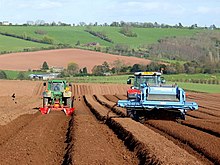Stone collector
A stone collector (also known as a stone swather depending on the type ) is an agricultural device for removing stones from fields.
function
Most devices take advantage of the size differences between rocks and clods of earth. Using sieves stones separated, cluttered with stone collectors into a bunker, similar in Steinschwadern as rakes in a row ( swath stored). The prerequisite is a weed-free soil that can be sieved. Crop residues such as corn stalks also interfere with the use of the devices.
Reasons for pitting fields
The pitting of fields has various advantages depending on the initial stocking (amount and size of stones in the arable land):
- Damage to rotating equipment such as power harrows is reduced. In addition, the risk of stones being thrown around is reduced.
- Uninterrupted work is also possible with tillage equipment without rotating parts such as plows due to the lower number of damage. For example, plows are widely protected against overload and serious damage with so-called stone protection devices by means of shear bolts ; pushing back the deflected part, removing the screw remnant and installing the new shear screw, however, costs a lot of work time.
- Purity of the crop: crops that grow in the ground, such as potatoes, are first harvested together with a lot of soil, soil can be sieved off, stones would have to be laboriously sorted out without prior pitting.
- Damage from stones on the tires of agricultural machines is reduced.
- If the arable land is initially occupied with stones, the vegetation is more even after the stones have been collected.
- In the case of root vegetables such as carrots , heavy stones in the soil can lead to tubers or beets that have grown irregularly and cannot be marketed.
Similar technique
In Beetanbau potatoes stones and Erdkluten be placed in windrows. The potato dams are specifically created between these swaths. The advantage here is that there are only a small percentage of clods of earth in the dams that interfere with harvesting. The process of growing beds is particularly widespread in Scandinavian countries.
Individual evidence
- ↑ cf. on the unsuitability of stony soils in carrot cultivation: Horst Köhler: The practical gardening book . 38th edition, C. Bertelsmann, Gütersloh 1952/1961, p. 412

